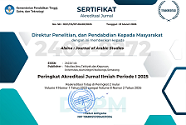Tren Pengembangan Media Pembelajaran Bahasa Arab di Indonesia Era 5.0
DOI:
https://doi.org/10.21580/alsina.6.1.21278Keywords:
Arabic learning, corpus approach, media development, research trendsAbstract
This study aims to analyze the development methodologies of Arabic language learning media that utilize technology in the 5.0 era, mainly through applications used in the learning process. With the onset of the 5.0 era in 2017, teachers are expected to harness advancing technologies to achieve educational objectives. This study employs the Corpus Approach by collecting 30 articles published over the last five years, between January 2019 and December 2023, using the Google Scholar search engine. The study focuses on identifying development methodologies, product outcomes, types of applications developed, year of publication, article indexing, and the skills (mahārah) intended to be achieved. The results indicate that most developers utilized Research and Development (R&D) methodologies, with 54% employing the ADDIE model, 30% using the Borg & Gall model, 7% using the 4D model, 6% employing the Hannafin Peck model, and 3% using the Lee & Owens model. 80% of the articles developed software applications for PC or Android, while 20% focused on hardware development. The year 2019 saw the highest number of articles submitted. Article indexing includes SINTA 2-5 and conference proceedings. The primary focus of skill development was on vocabulary (mufradāt) mastery and reading (qirā’ah). Feasibility tests showed that 100% of the products were rated as "very feasible and good," supported by validation tests from experts and pre-test and post-test evaluations conducted directly using either T-tests or limited-scale tests.
Downloads
References
Abdeldeen, Mahmoud, and Yi-Hsuan Fu. “The Challenges of Arabic Language Acquisition to the Non-Native Speakers in National Chengchi University, Taiwan: From the Perspective of the Current Students.” Dirasat: Human and Social Sciences 49, no. 3 (2022): 166–182. https://doi.org/10.35516/hum.v49i3.1342.
Abdelhadi, Reem, Luma Hameed, Fatima Khaled, and Jim Anderson. “Creative Interactions with Art Works: An Engaging Approach to Arabic Language-and-Culture Learning.” Innovation in Language Learning and Teaching 14, no. 3 (2020): 273–89. https://doi.org/10.1080/17501229.2019.1579219.
Abdul Ghani, Mohammad Taufiq, Mahizer Hamzah, Wan Ab Aziz Wan Daud, and Taj Rijal Muhamad Romli. “The Impact of Mobile Digital Game in Learning Arabic Language at Tertiary Level.” Contemporary Educational Technology 14, no. 1 (2022): ep344. https://doi.org/10.30935/cedtech/11480.
Al-Sulaiti, Latifa, and Eric Steven Atwell. “The Design of a Corpus of Contemporary Arabic.” International Journal of Corpus Linguistics 11, no. 2 (2006): 135–71. https://doi.org/10.1075/ijcl.11.2.02als.
Alam, Md. Samsul, Muhammad Atif, Chu Chien-Chi, and Uğur Soytaş. “Does Corporate R&D Investment Affect Firm Environmental Performance? Evidence from G-6 Countries.” Energy Economics 78 (2019): 401–11. https://doi.org/10.1016/j.eneco.2018.11.031.
Alfaifi, Abdullah, and Eric Atwell. “Arabic Learner Corpus v1: A New Resource for Arabic Language Research.” In Second Workshop on Arabic Corpus Linguistics (WACL-2), 1–4. Lancaster: Lancaster University, UK, 2013. http://eprints.whiterose.ac.uk/75470/.
Ateeq Alanezi, Mohammed. “An Efficient Framework for Intelligent Learning Based on Artificial Intelligence and IoT.” International Journal of Emerging Technologies in Learning (iJET) 17, no. 7 (2022): 112–24. https://doi.org/10.3991/ijet.v17i07.27851.
Benavides, Carlos. “Using a Corpus in a 300‐Level Spanish Grammar Course.” Foreign Language Annals 48, no. 2 (2015): 218–35. https://doi.org/10.1111/flan.12136.
Branch, Robert. “Instructional Design: The ADDIE Approach.” London: Springer Scienceþ Business Media, 2009. https://doi.org/10.1007/978-0-387-09506-6.
Delgado, Pablo, Cristina Vargas, Rakefet Ackerman, and Ladislao Salmerón. “Don’t Throw Away Your Printed Books: A Meta-Analysis on the Effects of Reading Media on Reading Comprehension.” Educational Research Review 25 (2018): 23–38. https://doi.org/10.1016/j.edurev.2018.09.003.
Elgamri, Alya, Zeinab Mohammed, Karima El-Rhazi, Manal Shahrouri, Mamoun Ahram, Al-Mubarak Al-Abbas, and Henry Silverman. “Challenges Facing Arab Researchers in Conducting and Publishing Scientific Research: A Qualitative Interview Study.” Research Ethics 20, no. 2 (2024): 331–62. https://doi.org/10.1177/17470161231214636.
Fadli, Muhammad Rijal. “Memahami Desain Metode Penelitian Kualitatif.” Humanika 21, no. 1 (2021): 33–54. https://doi.org/10.21831/hum.v21i1.38075.
Hidayat, Fitria, and Muhamad Nizar. “Model Addie (Analysis, Design, Development, Implementation and Evaluation) Dalam Pembelajaran Pendidikan Agama Islam.” Jurnal Inovasi Pendidikan Agama Islam (JIPAI) 1, no. 1 (2021): 28–38. https://doi.org/10.15575/jipai.v1i1.11042.
Hunston, Susan, and Gill Francis. “Pattern Grammar: A Corpus-Driven Approach to the Lexical Grammar of English.” Computational Linguistics 27, no. 2 (2001): 318–20. https://doi.org/10.1162/coli.2000.27.2.318.
Ikraama, Niswa, and Maslamah Maslamah. “Taṭwīr al-Wasā’il al-Taʿlīmīyah ‘Al-Podcast al-ʿArabī’ li-Taḥsīn Mahārat al-Istimāʿ al-ʿArabīyah li-Ṭalabat al-Madrasah al-Mutawassiṭah al-Islāmīyah.” Alsina : Journal of Arabic Studies 5, no. 1 (2023): 29–52. https://doi.org/10.21580/alsina.5.1.20204.
Jeong, Kyeong-Ouk. “Facilitating Sustainable Self-Directed Learning Experience with the Use of Mobile-Assisted Language Learning.” Sustainability 14, no. 5 (2022): 2894. https://doi.org/10.3390/su14052894.
Liu, Shangwen, Shijie Zhou, Hao Guan, Qian-Ming Zhang, Tong Qin, and Jiarong Lin. “Research on Enterprise R&D Strategy of Product-Service Innovation Guided by Quality Preference.” Sustainability 15, no. 11 (June 2, 2023): 9004. https://doi.org/10.3390/su15119004.
Ma, Hongxia, and Jing Li. “An Innovative Method for Digital Media Education Based on Mobile Internet Technology.” International Journal of Emerging Technologies in Learning (iJET) 16, no. 13 (2021): 68–81. https://doi.org/10.3991/ijet.v16i13.24037.
Martin-Martin, Alberto, Enrique Orduna-Malea, Anne Wil Harzing, and Emilio Delgado López-Cózar. “Can We Use Google Scholar to Identify Highly-Cited Documents?” Journal of Informetrics 11, no. 1 (2017): 152–63. https://doi.org/10.1016/j.joi.2016.11.008.
Mikki, Susanne. “Google Scholar Compared to Web of Science. A Literature Review.” Nordic Journal of Information Literacy in Higher Education 1, no. 1 (2009): 41–51. https://doi.org/10.15845/noril.v1i1.10.
Mustaufiy, Ahmad Syagif Hannany. “Peluang Dan Tantangan Pengembangan Literasi Digital Dalam Pembelajaran Bahasa Arab Pada Jenjang Pendidikan Dasar.” Fashluna 4, no. 1 (2023): 87–100. https://doi.org/10.47625/fashluna.v4i1.492.
Nurhayati, Muhammad Suib, and Fatoni. “Esensi Dan Sebab Kesulitan Berbahasa Arab Serta Penanganannya Dalam Dunia Pendidikan.” JURNAL TA’LIMUNA 1, no. 1 (2022): 84–91. https://e-journal.institutabdullahsaid.ac.id/index.php/jurnal-ta-limuna/article/view/137.
Panfilova, Valentina, Valentina Spichak, and Anargul Zhumakhanova. “Educational Mobile Games as a Tool for Increasing Vocabulary When Learning a Foreign Language.” International Journal of Web-Based Learning and Teaching Technologies 17, no. 1 (2022): 1–27. https://doi.org/10.4018/IJWLTT.298624.
Popović, Ilinka B. Mušikić, and Ilma Plojović. “Basic Paradigms of Implementation of Mass Media in Education.” SCIENCE International Journal 2, no. 3 (2023): 119–22. https://doi.org/10.35120/sciencej0203119m.
Ramalingam, Sangeeth, Melor Md Yunus, and Harwati Hashim. “Blended Learning Strategies for Sustainable English as a Second Language Education: A Systematic Review.” Sustainability 14, no. 13 (2022): 8051. https://doi.org/10.3390/su14138051.
Santiago, Leonardo P., and Veronica Mariana Oliveira Soares. “Strategic Alignment of an R&D Portfolio by Crafting the Set of Buckets.” IEEE Transactions on Engineering Management 67, no. 2 (2020): 309–21. https://doi.org/10.1109/TEM.2018.2876408.
Surur, Misbakhus. “Tantangan Dan Peluang Bahasa Arab Di Indonesia.” Risda: Jurnal Pemikiran Dan Pendidikan Islam 6, no. 2 (2022): 176–86. https://doi.org/10.59355/risda.v6i2.90.
Surya, Satyawati. “Corpus-Based Analysis of Transition Words.” In Sesanti: English Literature Departement, 189–200, 2023.
Taubah, Miftachul. “Maharah Dan Kafa’ah Dalam Pembelajaran Bahasa Arab.” Studi Arab 10, no. 1 (2019): 31–38. https://doi.org/10.35891/sa.v10i1.1765.
Zaghouani, Wajdi. “Critical Survey of the Freely Available Arabic Corpora.” In Proceedings of the Workshop on Free/Open-Source Arabic Corpora and Corpora Processing Tools, LREC, 1–8. Iceland: European Language Resources Association, 2014. http://www.lrec-conf.org/proceedings/lrec2014/workshops/LREC2014Workshop-OSACT Proceedings.pdf.
Zahwa, Feriska Achlikul, and Imam Syafi’i. “Pemilihan Pengembangan Media Pembelajaran Berbasis Teknologi Informasi.” Equilibrium: Jurnal Penelitian Pendidikan Dan Ekonomi 19, no. 1 (2022): 61–78. https://doi.org/10.25134/equi.v19i01.3963.
Downloads
Published
How to Cite
Issue
Section
License
Copyright (c) 2024 Alsina : Journal of Arabic Studies

This work is licensed under a Creative Commons Attribution-NonCommercial-ShareAlike 4.0 International License.
Copyright
The copyright of the received article shall be assigned to the publisher of the journal. The intended copyright includes the right to publish the article in various forms (including reprints). The journal maintains the publishing rights to published articles. Authors are allowed to use their articles for any legal purposes deemed necessary without written permission from the journal, but with an acknowledgment to this journal of initial publication.
Licensing
In order for Alsina: Journal of Arabic Studies to publish and distribute research articles, the editors need publishing rights (transferred from author to publisher). This agreement relates to the transfer/publishing copyright license to Alsina: Journal of Arabic Studies but the authors still have significant rights to use and share their published articles.
Alsina: Journal of Arabic Studies supports the need for writers to share, disseminate and maximize the impact of their research and their rights on any database. As a journal article writer, you have the right to various uses of your articles, including that by the institution or company where you work. Copyright can be used without the need for special permission. Authors who publish articles in the Alsina: Journal of Arabic Studies have broad rights to use their work for teaching and scientific purposes without requesting permission, including:
- Use by the author for lectures, presentations, or conferences, with distribution of copies to participants;
- Distribution to colleagues for research use;
- Use in compilations of the author's subsequent work;
- inclusion in a thesis or dissertation;
- Reuse of sections or excerpts from articles in other works (with full acknowledgment of the final article);
- Preparation of derivative works (other than commercial purposes) (with full acknowledgment of the final article);
- Voluntary posting on open websites operated by authors’ or writers' agencies for scientific purposes
When submitting a manuscript, authors do so on the understanding that if accepted for publication, the copyright for publishing (publishing right) of the article shall be assigned/transferred to Alsina: Journal of Arabic Studies.
Authors whose articles are accepted for publication will receive confirmation via email and sent a Copyright Transfer Agreement.

 Accreditation
Accreditation 
 In Collaboration with
In Collaboration with 

 Visitors
Visitors  Article Template
Article Template





